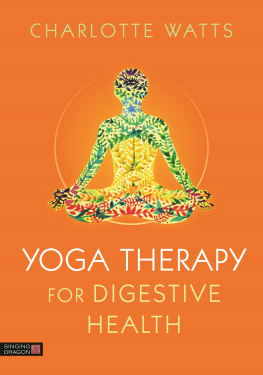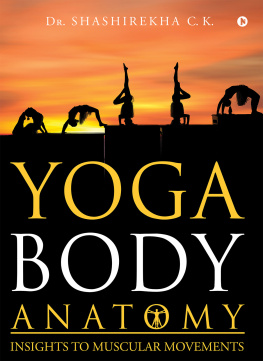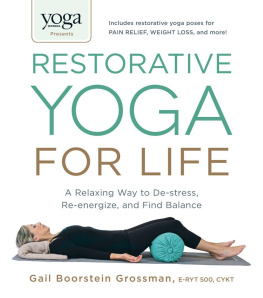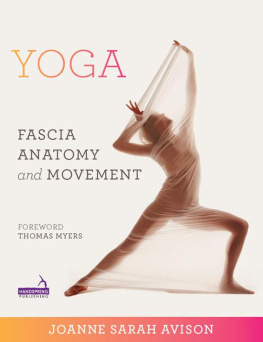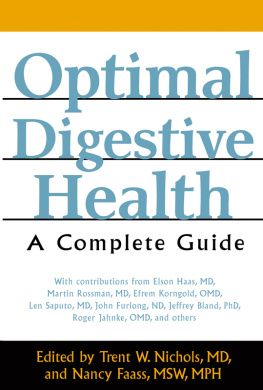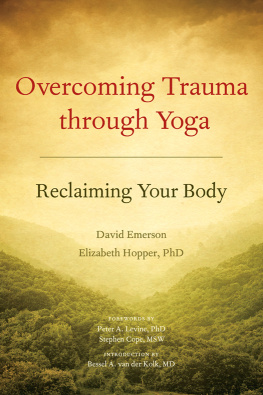
YOGA
THERAPY
for DIGESTIVE HEALTH
CHARLOTTE WATTS
Illustrated by Rafael Matigulin and Carl Bolton

Contents
Introduction
One of the reasons I first came to yoga, but mostly why my practice grew, was the profound effect it had on my long-term digestive issues: crippling Irritable Bowel Syndrome (IBS) from my early teens. I soon recognised that this expression of what I had struggled to digest, process and let go of was more than simply fixing a body system that wasnt functioning correctly; it also represented a whole-body psychotherapy and voices that needed to be listened to.
My journey with yoga and health has been part of that which is described in the Bhagavad Gita (verse 6.23) as Dissociation from the painful union with suffering. We do not need to separate the physical and psychic pain that we experience as humans; they are simply communicating via different routes. To heal such fracturing, I had a journey of gathering everything back to whole, back to the centre, to the midline (from where we grow out as an embryo) facing the often-difficult voices in my upset belly. For me, exploration of healing digestive dis-ease was very much part of my coming home to union of mind and body.
As I have continued along my explorative journey with holistic and systemic health, my personal philosophy has increasingly come to challenge reductionist thinking that partitions the way that we see our body and mind, the way that we view body systems and the way that we might separate out Western ideologies such as psychology and physiology.
It is far too simplistic to say that this modern reductionism is correct because it is scientific. It is easy to dismiss older cultural and spiritual viewpoints simply because they are traditional and, by this very fact, must be non-scientific. For many, it is too great a leap to introduce a poetic element into what we know as fact, but the evidence speaks volumes for the health and quality of life improvements that a regular yoga practice brings.
The recent work discussing the enteric nervous system (aka the Second Brain) has challenged views of the digestive system as a place of the simple grind of food in, food out. It has allowed us to view this enormous, cognisant, central channel from which we evolved as that which sits at the very depths of our being: so important in yoga philosophy as the mystical midline, sushumna , from where gut feelings are true and from where we make billions of unconscious decisions every second on how we feel about the world around us. Yogis have known this for centuries, but it is a symptom of our times that unless something is in our chosen language and culture, we may not be open to accepting it as truth. As we will explore, gut feelings are indeed real and if we are shut off from feeling or listening to them, our bodies can try and shout louder to be heard. If initial gut rumbles are not attended to, these can show up as more pronounced conditions down the line.
Digestive issues are on the rise and prove difficult to address through mainstream medical routes. This is not least because of their connection with and root in the rise of psycho-social stress and poor dietary habits. In recent years there have been illuminating thought-shifts in neuroscientific understanding, the acknowledgement of fascia as a major body system and the link between the gut and the brain. We are learning more and more about how engaging with the nervous system (NS) and talking to the gut via attunement and self-compassion can have far-reaching effects that unravel conditions like IBS, Inflammatory Bowel Disease (IBD), acid reflux, colitis, diverticulitis and more.
The modern world has us stuck up in our heads, and a connection down into our centre and our root embodied awareness has the effect of dampening down that mind-hum. The essence of yoga is stilling the mind and the physical practice often referred to as Modern Postural Yoga was added later in its history to provide a route for embodied awareness and moving through that which we might physically, as well as mentally, hold on to.
Yoga is a philosophy of connection, liberation and moving beyond our suffering as an individual consciousness to meld with the universal to transcend. Along the way, it was noticed that this journey also conferred health benefits and yoga as therapy emerged. This is not to be confused with the modern, reductionist pill for an ill approach to health or suppression of symptom. Yoga reveals that which was already there the profound truth that we are whole and along with Ayurveda seeks to uncover the energetic imbalances that hold us expressing dis-ease.
Occupying our bodies to find expanse, connection and liberation can have profound effects on digestive function. Whether we view this via scientific exploration of the gut-brain axis or through traditional yogic philosophies, either viewpoint acknowledges that our holding of early trauma creates habits of response in the belly that need to be listened to with kind attention. The difference in how such information might be used is that yoga views the individual first and modern medicine treats the disease.
Yoga offers this (if we slow down to feel) via the rest and digest parasympathetic tone of the NS the opposite of the fight-or-flight response. Asana (posture) practice physically moves into the fascia around and between organs, freeing space, glide, fluidity, mobility and tone into all of the physiology in the abdominal cavity. Breath awareness and control allows the breath to drop into the belly and diaphragm, a basic need for optimal digestive function.
Stretching, compressing and twisting of the gastrointestinal (GI) tract and viscera (organs) are a large part of supporting digestive health within yoga traditions. As free-flow of fluids, movement and energy in this area is so deeply connected with the spine and rising of the Kundalini (generative matrix of the universe or divine power) to bring it into consciousness, focus here is never purely physical in yoga. When we choose to turn inwards and listen, we can become aware of the rich communication this central part of our being offers.
Yoga is cheap, non-invasive and safe and studies tend to show good results as people keep it up, not just because of a desired health effect, but also because of the full mind-body benefits and insight it brings. It is an engaging practice; the deeper connection beyond a purely physical workout encourages people to continue and genuinely value all facets of the experience.
There is an exponential growth in yoga research being carried out, as well as a rise in the quality of studies and the positive attention these receive. This is particularly true in the areas of stress and anxiety, inextricably linked with digestive disorders. A review of the current IBS research and most effective treatments stated:
Progressive muscle relaxation exercises are used to reduce the sensitivity of the bodys viscera. Relaxation exercises such as breathing, yoga, meditation, Tai Chi, bathing are commonly used. These types of exercises could be helpful to relief [sic] general stress condition and the associated IBS symptoms. More importantly, these exercises are particularly attractive as they have no major adverse effects. (Tsang et al. 2016)
We know that how we move isnt simply relegated to joints and muscles but reaches out from the fascia that wraps around organs, particularly our visceral organs, those in the abdomen that sit asymmetrically and move that movement defined by how fluid or viscous the tissues between the organs might be. These express the state of our central nervous system and that continual discussion between gut and brain. We move outwards from this centre to feel the world and bring that information back to it to process and understand. Our gestures and, ultimately, movement forms all stem from this somatic, poetic orchestration, revealing so very much about the ripples of our past in the present moment.
Next page
